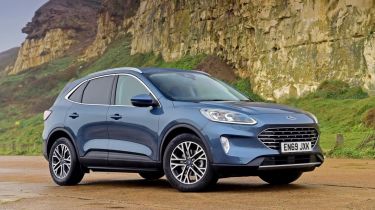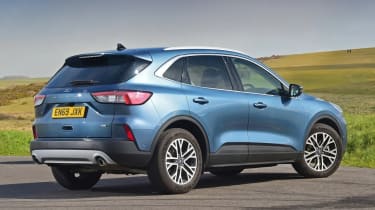Used Ford Kuga Mk3 (2020-date) review: a popular and desirable mid-size SUV
A full used buyer’s guide on the Ford Kuga covering the Kuga Mk3 that has been on sale since 2020
Verdict
Compact SUVs have been hot property for a while, so the stakes were high when Ford launched its Mk3 Kuga. It’s fair to say the car maker hit the spot, because the car became a best seller as soon as it arrived. It was nominated as our Mid-Size SUV in our 2020 New Car Awards, and it came out on top against the Skoda Karoq and Toyota RAV4 in a group test in summer 2020. At the time we said: “The Ford Kuga is still the family SUV for keen drivers, because it handles brilliantly, but in Titanium spec it’s cheaper and better equipped than the Karoq – and nearly as versatile, despite slightly less passenger room”. As a used buy, the Kuga is no less compelling.
Ford is a company that makes cars accessible, thanks to its wide model ranges and large production volumes. For those buying used, these factors have always made the firm’s wares even more tempting, courtesy of keen prices, and that’s certainly the case where the Kuga is concerned.
Compact SUVs started to become popular in the early noughties, and while some of Ford’s efforts around that time weren’t all that accomplished (think Maverick and Explorer), by 2008 the Mk1 Kuga had been launched. It was just what buyers wanted: a road-biased SUV that was good to drive, looked smart and offered decent value.
Used - available now
The sequel provided more of the same, while the third take was even better when it was unveiled at the end of 2019. We ranked it top of the class at the time, in fact.
History
The Kuga Mk3 hit the UK in January 2020. Just one petrol engine was available – a 1.5-litre EcoBoost unit with 119bhp or 148bhp.
Diesel fans could choose between 1.5 and 2.0 EcoBlue engines. The former came only in 119bhp form, while the latter was offered with mild-hybrid (MHEV) tech in 148bhp guise, or there was a non-hybrid 187bhp option. There was also Ford’s first ever plug-in hybrid (PHEV), a 222bhp car with a 2.5-litre petrol engine.
A year later, a full hybrid was introduced, with a 2.5-litre petrol engine. Sold as the Kuga Hybrid, it was rated at 187bhp and was claimed to have a range of up to 600 miles. Ford axed all diesel versions in December 2021, leaving only the petrol, hybrid and plug-in hybrid options.
Which one should I buy?
The diesels have decent muscle (entry-level models aside) and are frugal, while petrol models cost more to buy and the fuel bills will be higher. The plug-in hybrids make sense if you can charge at home and don’t do mainly long-distance motorway trips.
All Kugas are well equipped, with the entry-level Zetec having 17-inch alloy wheels, a heated windscreen, an eight-inch touchscreen, cruise control, plus front and rear parking sensors. Titanium models have 18-inch wheels, a powered tailgate, keyless entry, dual-zone climate control, digital instrumentation, a 10-speaker hi-fi and a rear parking camera.
Vignale adds a heated steering wheel, leather trim, heated rear seats and 19-inch rims. The ST-Line Edition has a bodykit, and the ST-Line X gets heated front and rear seats and steering wheel, plus a glass roof.
Alternatives to the Ford Kuga
Two very desirable rivals are the Kia Sportage and Hyundai Tucson, which are good value, plentiful, and come with long warranties. The Volkswagen Group has the VW Tiguan (also in seven-seater Tiguan Allspace form), Skoda Karoq and SEAT Ateca. All are desirable for their impressive build quality, user-friendliness, ready availability and efficient engines.
The Mazda CX-5 looks great inside and out, is good to drive and well made. The Nissan Qashqai is plentiful, good value and practical, while the Peugeot 3008 looks smart and has an impressive interior. The Renault Kadjar is roomy and stylish, while the Toyota RAV4 promises reliability and a user-friendly cabin. Ford’s Puma is smaller, but leads its class as a superb all-rounder, so it’s worth a look if the Kuga is too big.
What to look for
Fuelling
All Kugas come fitted with Ford’s Easy Fuel system as standard, so you can’t put the wrong fuel into your car by mistake.
Spare wheel
Kugas don’t have a spare wheel; a space-saver item is available at extra cost for all models, apart from the 2.0 EcoBlue MHEV.
Towing
The plug-in hybrid can tow just 1,200kg, the 1.5 EcoBlue between 1,500-1,800kg, while the 2.0 EcoBlue can pull 1,900-2,100kg.
Extras
Option packs available include Technology (head-up display, LED headlights), and Driver Assistance (adaptive cruise control, active park assist and more).
Interior
With a user-friendly layout and a decent standard of fit and finish, the Kuga’s cabin is hugely appealing, although you might find the front seats flat and unsupportive, especially on long journeys.
Interior space is good, with enough head and legroom room to carry five adults – but no more, because there’s no seven-seat option available.
Versatility is improved by the inclusion of a sliding rear seat, which allows between 412 and 612 litres of boot capacity in five-seat mode. Fold the back seats down and this boosts load volume to 1,423-1,478 litres with a spare wheel in place, or 1,481-1,534 litres with a tyre-repair kit instead.
Prices
There’s no shortage of Kugas on the second-hand market; we found almost 2,000 of them, half of which were diesels, a quarter plug-in hybrids, about five per cent hybrids and the other 20 per cent petrol-engined.
To check prices on a specific model head over to our valuation tool.
Running costs
All Mk3 Kugas have to be serviced every two years or 18,000 miles, with the first check-up pegged at £200. After this the schedule alternates between minor and major, at £225 and £275-£500 respectively. Ford offers an Essential service for £209, which is an oil and filter change, top-ups of the various fluids (brake, coolant, windscreen washer), and a check of all key systems. The brake fluid should be renewed every two years (£75) and the coolant every 10 years (£100).
The 2.0-litre diesel engine has a cambelt that has to be replaced every 10 years or 120,000 miles, at a cost of about £500. The 1.5 EcoBoost engine’s cambelt has to be renewed every 10 years or 150,000 miles; the cost is a hefty £1,500 or so.
Recalls
Ford has recalled the Kuga eight times so far, with three campaigns aimed specifically at the plug-in hybrid. The latter were issued in July, September and December 2020. The first campaign was because a connector within the control unit for the high-voltage battery could be damaged, the second time because the battery pack could overheat, while the third recall was because of short circuits within the battery pack.
Just one Kuga diesel was recalled in September 2020, because of a faulty auxiliary heater, then in May 2021, 100 Kugas were recalled because of eCall software glitches. This led to another recall in July 2022, just days after a campaign was launched to tackle oil and fuel leaks in Kugas made up to summer 2022. The most recent recall came in November 2022, because of glass roofs detaching on some examples made in 2021.
Driver Power owner satisfaction
A 19th place (out of 75 entries) in the 2021 Driver Power new-car survey is good; the Kuga achieved 33rd in 2022, then an impressive 15th in 2023, when the worst score was 59th for servicing costs, with overall quality in 56th. But there’s no shortage of highlights, including 13th for safety features, eighth for infotainment, 12th for visibility and 10th for the brakes. A 19th spot for value is also very encouraging.














